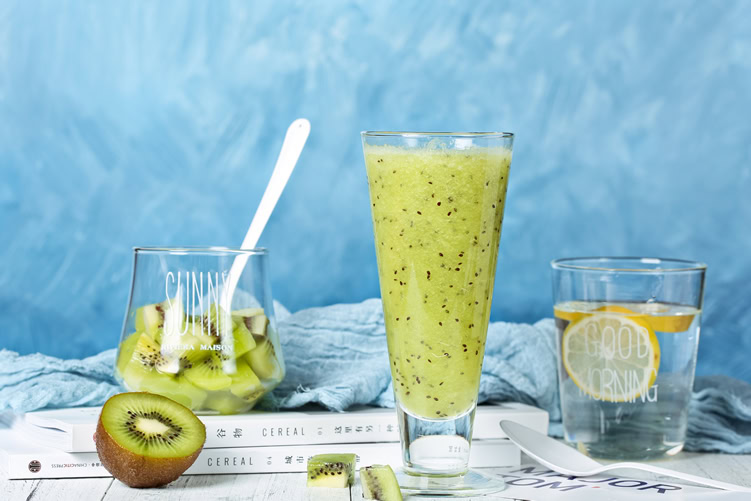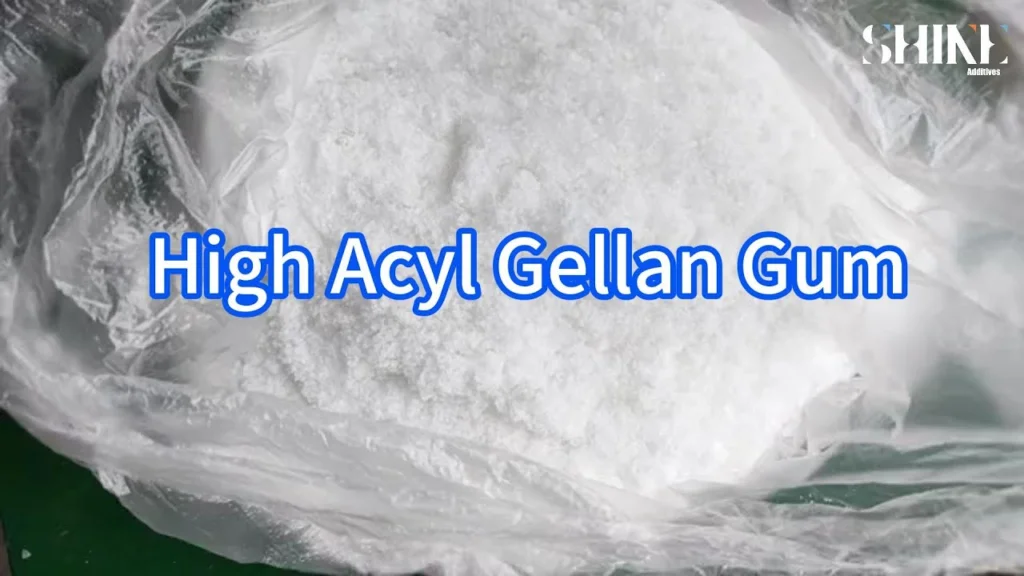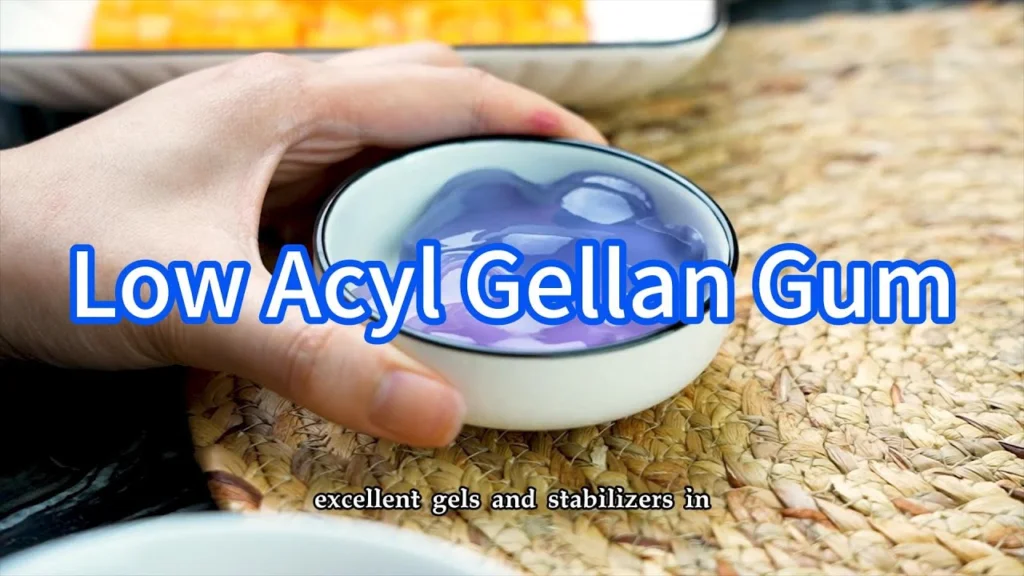When it comes to selecting the perfect gelling agent for your product, the choice between high acyl gellan gum and low acyl gellan gum is pivotal. Both variants offer unique properties that can significantly influence the texture, stability, and overall appeal of the final product. Shine, a leading name among gellan gum manufacturers, stands at the forefront of supplying both high-quality high acyl and low acyl gellan gum, catering to a diverse range of application needs. Understanding the distinct characteristics of each can help you make an informed decision, ensuring your product not only meets but exceeds market expectations.
High acyl gellan gum is celebrated for its ability to produce a soft, elastic gel, which is highly sought after in applications requiring a flexible, non-brittle texture. Its versatility makes it an indispensable ingredient in a variety of food products, from desserts and confectionery to dairy alternatives. On the other hand, low acyl gellan gum is renowned for forming firm, brittle gels, making it the go-to option for products demanding a strong, stable gel structure without syneresis (the leaking of liquid). This characteristic is particularly beneficial in applications such as jellies, structured beverages, and some dairy products.

The choice between high acyl and low acyl gellan gum ultimately hinges on the specific requirements of your product. For those seeking a delicate, tender texture, high acyl variants offered by Shine and other gellan gum suppliers provide the perfect solution. Conversely, for products where rigidity and form retention are paramount, low acyl gellan gum emerges as the ideal choice. This decision not only affects the sensory attributes of the product but also its processing and shelf-life characteristics.
In the competitive landscape of food and beverage manufacturing, staying informed about the latest trends and innovations is crucial. Both high acyl and low acyl gellan gum are at the forefront of these trends, offering manufacturers the opportunity to innovate and tailor their products to meet evolving consumer preferences. Shine, along with other gellan gum suppliers, continuously explores new applications and improvements in gellan gum technology, ensuring that their clients have access to the best ingredients for their needs.
To sum up, the decision between high acyl and low acyl gellan gum should be guided by the specific textural and structural requirements of your product. Understanding the unique benefits of each can empower you to make choices that enhance your product’s appeal and performance. Whether you’re formulating a new beverage, designing a novel dessert, or innovating in the dairy alternatives space, Shine’s range of gellan gum products offers the versatility and quality you need to succeed.
Understanding Gellan Gum
Gellan gum, a powerhouse in the world of modern food science and beyond, stands out as a versatile gelling agent that has captured the attention of both Gellan Gum Manufacturers and Gellan Gum suppliers alike. Its origins trace back to a bacterium discovered in a natural lily pond, setting the stage for what would become a key ingredient in the arsenal of food technologists and product developers. Shine, as a brand, has been at the forefront of harnessing the potential of gellan gum, offering both High Acyl Gellan Gum and Low Acyl Gellan Gum to meet the diverse needs of the industry.
The magic of gellan gum lies in its ability to create gels. But not just any gels – these are gels that can be fine-tuned for texture, firmness, and clarity, making it a go-to choice for a wide range of applications. From the jelly-like consistency in your favorite candies to the stable structure in plant-based milks, gellan gum is the unsung hero that makes these textures possible. Its functionality extends beyond food, finding its place in non-food applications such as cosmetics and pharmaceuticals, showcasing its versatility.

Understanding the difference between High Acyl Gellan Gum and Low Acyl Gellan Gum is crucial for manufacturers aiming to perfect their product’s texture. High Acyl Gellan Gum offers a softer, more elastic gel, ideal for products that require a flexible yet stable consistency. On the other hand, Low Acyl Gellan Gum creates firm, brittle gels, perfect for items that demand a strong, non-syneresis gel structure. This distinction is not just technical jargon; it’s the key to unlocking the desired sensory experience in a wide array of products.
Shine, alongside other Gellan Gum suppliers, has been instrumental in bringing this ingredient to the market, providing manufacturers with the tools needed to innovate and excel. The choice between High Acyl and Low Acyl Gellan Gum is not merely a decision about texture; it’s about envisioning the end product and understanding how each form of gellan gum can bring that vision to life. As the industry evolves, the applications of gellan gum continue to expand, driven by the creativity and ingenuity of product developers who understand its potential.
In conclusion, gellan gum represents a critical component in modern product formulation, offering unmatched versatility and functionality. Whether you’re developing a new beverage, a novel dessert, or an innovative cosmetic product, understanding the properties and applications of High Acyl and Low Acyl Gellan Gum is essential. Shine, as a leading name among Gellan Gum Manufacturers, remains committed to providing high-quality gellan gum solutions, empowering brands to create products that stand out in today’s competitive market.
Characteristics of High Acyl Gellan Gum
High Acyl Gellan Gum, a product that stands out in the portfolio of Shine, a leading name among Gellan Gum Manufacturers, is renowned for its unique textural properties. This variant of gellan gum is engineered to deliver a soft and elastic gel texture, a characteristic highly sought after in various food and non-food applications. Unlike its counterpart, Low Acyl Gellan Gum, which is known for creating firm and brittle gels, High Acyl Gellan Gum is designed to provide a more flexible consistency.

The elasticity and softness of High Acyl Gellan Gum make it an ideal choice for products that require a delicate yet stable gel structure. From dairy products to plant-based beverages, the versatility of this gellan gum variant offered by Shine and other Gellan Gum suppliers is unparalleled. Its ability to form gels that can withstand a wide range of temperatures and pH levels further adds to its appeal, making it a go-to ingredient for manufacturers aiming to innovate or improve the texture of their products.
One of the remarkable features of High Acyl Gellan Gum is its synergy with other hydrocolloids, which can be leveraged to tailor the texture and viscosity of the final product. This property is particularly beneficial in complex formulations, where the balance of ingredients is crucial to achieving the desired product characteristics. The ability to fine-tune the gel strength and elasticity allows product developers to create a sensory experience that can distinguish their products in a competitive market.
Moreover, the transparency and thermal reversibility of gels formed by High Acyl Gellan Gum are aspects that cannot be overlooked. These properties enable the creation of visually appealing products that can undergo heating and cooling processes without losing their gel integrity. This aspect is especially valuable in the culinary and food service industries, where visual appeal and consistency of texture are paramount.
In conclusion, High Acyl Gellan Gum, as offered by Shine and other esteemed Gellan Gum suppliers, is a versatile and functional ingredient that can significantly enhance the textural attributes of a wide range of products. Its unique characteristics, including softness, elasticity, and the ability to withstand various processing conditions, make it an indispensable tool for manufacturers seeking to innovate or improve the quality of their offerings.
Benefits of Low Acyl Gellan Gum
When it comes to enhancing the texture and stability of various products, Low Acyl Gellan Gum stands out as a remarkable choice for manufacturers and formulators alike. This variant of Gellan Gum, distinguished from its High Acyl counterpart, offers a unique set of advantages that can significantly benefit product formulations across a wide range of industries. Let’s delve into the key benefits that make Low Acyl Gellan Gum a preferred ingredient for those aiming to achieve a precise, firm gel structure in their products.

Firstly, the most notable characteristic of Low Acyl Gellan Gum is its ability to form firm and brittle gels. This property is particularly advantageous for products that require a strong, stable gel matrix without the risk of syneresis (the weeping of liquid from a gel). This makes it an ideal choice for applications such as jellies, structured desserts, and even certain types of cheeses where texture integrity is paramount.
Moreover, Low Acyl Gellan Gum’s compatibility with a wide range of ingredients and conditions adds to its versatility. It can effectively gel in the presence of various ions and withstand a broad spectrum of pH levels, making it suitable for a diverse array of product formulations. This adaptability simplifies the formulation process for Gellan Gum Manufacturers and suppliers, allowing them to cater to the specific needs of their clientele more efficiently.
Another significant benefit of using Low Acyl Gellan Gum is its contribution to the clarity and visual appeal of products. Unlike some gelling agents that may impart a cloudy appearance, Low Acyl Gellan Gum forms clear gels. This characteristic is especially valued in products where aesthetic appeal is as important as texture, such as in certain beverages and decorative food items.
From an economic standpoint, the efficiency of Low Acyl Gellan Gum cannot be overlooked. Due to its high gel strength, only small quantities are needed to achieve the desired gelling effect, making it a cost-effective option for manufacturers. This efficiency not only reduces the overall cost of production but also aligns with the sustainability goals of reducing resource consumption.
Lastly, the use of Low Acyl Gellan Gum aligns with the clean label trend that is increasingly becoming a priority for consumers. As a naturally derived ingredient, it meets the demand for products composed of recognizable and minimally processed ingredients. This aspect is particularly appealing to Gellan Gum suppliers and manufacturers, including Shine, who are committed to meeting consumer expectations for natural and healthy product options.
In conclusion, Low Acyl Gellan Gum offers a suite of benefits that make it a standout choice for manufacturers looking to enhance the texture, stability, and overall quality of their products. Its firm gelling properties, versatility, clarity, cost-effectiveness, and alignment with clean label trends underscore its value in the formulation toolbox. As the industry continues to evolve, the role of Low Acyl Gellan Gum in meeting the sophisticated demands of consumers and manufacturers alike is undoubtedly set to grow.
Comparative Analysis: High Acyl vs. Low Acyl
When it comes to selecting the right gellan gum for your product, understanding the nuanced differences between high acyl gellan gum and low acyl gellan gum is crucial. Both types offer distinct advantages, but their applications can greatly impact the final product’s texture and stability. In this comparative analysis, we’ll dive into the specifics of each type, providing insights to help manufacturers, including those working with the Shine brand, make informed decisions. As gellan gum suppliers and manufacturers continue to innovate, the versatility of these ingredients becomes even more pronounced.
High acyl gellan gum is known for its ability to produce a soft, elastic gel, which is highly sought after in applications requiring a flexible, non-brittle texture. This makes it an excellent choice for products like jellies, dairy alternatives, and some desserts where a delicate, chewy consistency is desired. The unique textural properties of high acyl gellan gum also contribute to its ability to withstand various processing conditions, making it a versatile option for a wide range of applications.

On the other hand, low acyl gellan gum forms firm, brittle gels, which are ideal for products that require a strong gel structure. This type of gellan gum is often used in the production of structured foods, such as plant-based meats, aspic, and certain confectioneries. The firmness of the gel created by low acyl gellan gum also means that it is less prone to syneresis (the expulsion of water), making it a preferred choice for products that need to maintain their shape and texture over time.
When comparing the two, it’s essential to consider the specific needs of your product formulation. For instance, Shine, a brand known for its commitment to quality and innovation, might opt for high acyl gellan gum when developing a new line of vegan desserts, aiming for a soft, smooth texture. Conversely, for a product that requires a more defined shape, such as vegan gelatin cups, low acyl gellan gum could be the better option.
Below is a brief overview of the key differences between high acyl and low acyl gellan gum:
| Aspect | High Acyl Gellan Gum | Low Acyl Gellan Gum |
|---|---|---|
| Texture | Soft, Elastic | Firm, Brittle |
| Syneresis | Low | Minimal |
| Application | Jellies, Dairy Alternatives, Soft Desserts | Plant-Based Meats, Aspic, Firm Desserts |
| Processing Conditions | Flexible | More Defined |
In conclusion, whether you’re a gellan gum manufacturer or a supplier, understanding the specific properties and applications of high acyl and low acyl gellan gum is essential. By carefully considering these factors, brands like Shine can select the most appropriate type of gellan gum for their product, ensuring the desired texture and quality are achieved. As the industry continues to evolve, staying informed about these differences will be key to innovation and success.
Choosing the Right Gellan Gum for Your Product
When it comes to incorporating gellan gum into your product, the choice between high acyl gellan gum and low acyl gellan gum can significantly impact the final texture and stability of your product. Understanding the unique properties of each type is key to achieving the desired outcome. Shine, as a leading brand in the industry, along with numerous gellan gum manufacturers and suppliers, offers both high acyl and low acyl options to cater to a wide range of application needs.

High acyl gellan gum is known for its ability to produce a soft, elastic gel, which is perfect for applications where a flexible consistency is desired. This makes it an excellent choice for products like jellies, dairy products, and some dessert applications where a smooth, elastic texture enhances the consumer experience. On the other hand, low acyl gellan gum forms firm, brittle gels, making it ideal for products requiring a strong gel structure, such as structured desserts and certain types of sauces that need to maintain their shape and consistency without syneresis (water leakage).
When deciding between high acyl and low acyl gellan gum, consider the following factors:
- Desired Texture: Evaluate whether your product requires a soft, elastic texture or a firm, brittle gel structure. This decision will largely influence whether high acyl or low acyl gellan gum is more suitable for your application.
- Application Process: The processing conditions and ingredients in your formulation can affect how gellan gum behaves. High acyl variants might be more tolerant to certain processing conditions, while low acyl types could offer better gel strength under different circumstances.
- Compatibility with Other Ingredients: Both types of gellan gum interact differently with various ingredients, such as ions and pH levels. Understanding these interactions is crucial for selecting the right type for your product.
- Final Product Clarity: If clarity is a critical attribute of your product, low acyl gellan gum typically provides a clearer gel compared to high acyl gellan gum, which might be an essential factor in products like certain beverages or gel-based desserts.
Shine, along with other gellan gum manufacturers and suppliers, often provides detailed product specifications and application guides to help product developers make informed decisions. Collaborating closely with suppliers can offer additional insights into how gellan gum can be optimized for your specific application, taking into account factors like ingredient interactions, processing conditions, and sensory attributes.
In conclusion, the choice between high acyl and low acyl gellan gum depends on a complex interplay of factors including desired texture, processing conditions, ingredient compatibility, and final product attributes. By understanding these nuances and working closely with reputable gellan gum suppliers like Shine, manufacturers can unlock the full potential of gellan gum in their product formulations, ensuring the optimal texture and stability that meet consumer expectations.
Future Trends in Gellan Gum Use
The landscape of food additives is ever-evolving, with innovations and trends shaping the way we think about what goes into our food. Gellan gum, both high acyl and low acyl varieties, is no exception. As we look towards the future, several emerging trends stand out, promising to influence how Gellan Gum manufacturers and suppliers, including the brand Shine, navigate the market.
Firstly, the push towards plant-based and vegan products is more than just a trend; it’s a movement. As consumers become increasingly conscious of their dietary choices’ impact on health and the environment, the demand for vegan-friendly stabilizers like high acyl gellan gum is expected to rise. This form of gellan gum, known for its ability to provide a soft and elastic gel texture, is ideal for plant-based dairy alternatives, offering the creamy consistency consumers desire without animal-derived ingredients.

On the other hand, low acyl gellan gum, celebrated for its ability to form firm and brittle gels, is finding its place in innovative food and beverage applications. As manufacturers strive to create products with unique textures and longer shelf lives, low acyl gellan gum emerges as a key player. Its ability to maintain stability and texture in products subjected to extreme temperatures makes it a valuable asset in the development of shelf-stable beverages and desserts.
Another trend that cannot be ignored is the clean label movement. Consumers are demanding more transparency and simplicity in the ingredients list, and gellan gum fits the bill. Recognized as a natural ingredient, gellan gum’s appeal is likely to grow. Shine, along with other Gellan Gum manufacturers and suppliers, is poised to benefit from this trend, promoting gellan gum as a clean and versatile ingredient suitable for a wide range of applications.
Technology also plays a crucial role in the future of gellan gum. Advances in extraction and purification techniques have made it possible to produce gellan gum more efficiently and sustainably. This not only benefits manufacturers but also aligns with the growing consumer demand for environmentally friendly production practices. As technology continues to evolve, we can expect to see even more innovative uses for both high acyl and low acyl gellan gum in food science.
In summary, the future of gellan gum use is bright, with trends like plant-based diets, the clean label movement, and technological advancements shaping its path forward. For brands like Shine, staying at the forefront of these trends is essential. By continuing to supply high-quality high acyl and low acyl gellan gum, Shine and other suppliers can help manufacturers meet the evolving demands of consumers, ensuring that gellan gum remains a staple ingredient in food and beverage production for years to come.
Frequently Asked Questions
- What is Gellan Gum?Gellan gum is a powerhouse of a gelling agent that’s used to jazz up a variety of food and non-food items. Think of it as the secret ingredient that gives some of your favorite jellies, puddings, and even some cosmetics that perfect texture. It’s all about making things feel just right, whether that’s adding a bit of wobble to your dessert or ensuring your face cream glides on smoothly.
- How do High Acyl and Low Acyl Gellan Gum differ?Picture High Acyl Gellan Gum as the life of the party, bringing soft, elastic vibes to the gel world. It’s all about flexibility and bounce, making it a go-to for products that need to keep things light and jiggly. On the flip side, Low Acyl Gellan Gum is the firm handshake of the gel universe. It’s all business, delivering firm, brittle gels that stand their ground, perfect for when you need a strong, supportive texture. So, depending on whether you’re after a gentle wiggle or a steadfast hold, you’ve got options.
- Which type of Gellan Gum should I choose for my product?Choosing between High Acyl and Low Acyl Gellan Gum is like picking your outfit for the day; it all depends on the occasion (or in this case, your product). If your product is aiming for a soft, elastic texture, like a pudding that needs to jiggle but not break, High Acyl is your best bet. But if you’re looking to create something with a bit more structure, like a gummy candy that holds its shape, Low Acyl will be your hero. Consider the texture you’re dreaming of, and let that guide your choice.
- Can Gellan Gum be used in both food and non-food applications?Absolutely! Gellan Gum is a bit of a chameleon. In the food world, it’s used to perfect the texture of a wide range of products, from vegan jellies to plant-based milks. But its talents don’t stop there. In non-food applications, Gellan Gum steps up as a stabilizer and texture enhancer in products like cosmetics, helping your face cream stay creamy and your shampoo lusciously thick. It’s all about versatility with this ingredient.
- What are the future trends in Gellan Gum use?The future of Gellan Gum is looking as stretchy and exciting as the ingredient itself. With the food industry constantly on the hunt for the next big thing in textures and sustainable ingredients, Gellan Gum is stepping into the spotlight. Expect to see it popping up in more plant-based and clean-label products, pushing the boundaries of texture and consistency. And as consumers become more ingredient-savvy, the demand for versatile, natural thickeners like Gellan Gum is only going to skyrocket. Stay tuned for a gel-tastic future!
